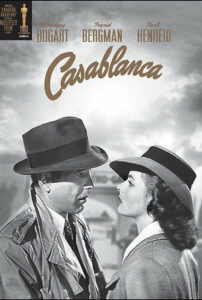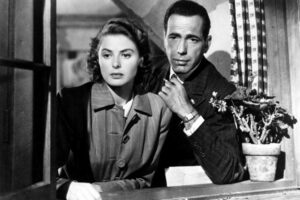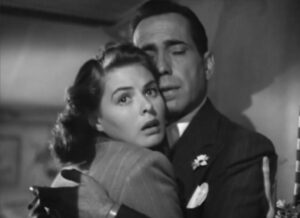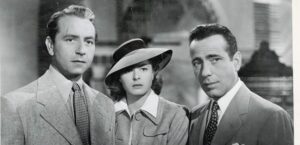“Casablanca” – in a Suffocating Web of Appearances

Title: “Casablanca”
Release Date: 1942
Director: Michael Curtiz
Cast: Humphrey Bogart, Ingrid Bergman, Paul Henreid, Claude Rains, Condrad Veidt, etc.
“Casablanca” is usually seen as a noir-styled melodrama about unhappy love in difficult war times. Nevertheless, it is also a fascinating portrayal of human existence trapped in a world of appearances, where nobody is who they seem to be. Thus, cynical and cold Rick is a sentimental dreamer, French collaborator is guided by patriotism, and innocent Ilsa calculatingly exploits men’s feelings.
Despite the passage of time, “Casablanca” – a film considered one of the most important works in the history of cinema – is not a work to be discarded. On the contrary, thanks to its special atmosphere, beautiful cinematography and distinctive protagonist, “Casablanca” still touches the viewer and forces to follow the world created by it. And it is a truly bizarre reality: a city in Morocco under the French protectorate during World War II is, in a way, Europe’s great waiting room. War refugees from across the old continent are drawn here to fly to neutral Lisbon, and then to the USA – the bastion of the free world.
“Casablanca” – the world as prison
It is this temporality of the characters’ situation, this atmosphere of nervous anticipation that gives the film its unique tension, which is felt until the very last scene. It is no coincidence that one of the main symbolic props of the work is an airplane, which every evening is watched with longing in their eyes by the migrants gathered in Casablanca. The plane is a kind of vehicle that is supposed to transport the characters to another, better dimension. However, airline tickets are only available to a select few, so black market trade flourishes.

Even the opening scenes of the film focus on the various dramatic steps the emigrants take to get to their dream paradise. Everyone has something to sell: an aristocrat gives away her ancestral jewelry for next to nothing, while a young married woman intends to give herself to a local official in exchange for airline tickets. There is only one person in “Casablanca” who doesn’t care about going to America. That’s Rick (Humphrey Bogart), an American who runs the most popular nightclub and earns a fortune from gambling guests.
And right in the middle of this international melting pot comes war hero Victor Laszlo with his beautiful wife Ilsa, who turns out to be Rick’s former sweetheart. It is clear from the start that the man wanted by the Gestapo will want to get a pass to the U.S. and that this will have consequences for all the people involved in the love triangle.
Rick’s diner is the center of events in the film. A smoky bar full of newcomers playing roulette and drowning their sorrows in alcohol to the sound of sentimental music is the quintessential “Casablanca” atmosphere. The aura of a carefree night life is only a pretense under which danger lurks. Rick’s place is under constant surveillance by Vichy state officials and German spies. The lack of open-air locations, the confined quarters of nightclubs, hotel interiors, and interrogation rooms build a thickening atmosphere of danger.
Moreover, the film is clearly set in noir aesthetics. So we have the classic elements of black cinema: night, shady dealings, and guns. Interestingly, as the first reviewers of Casablanca noticed, even the play of chiaroscuro is of great importance here. The shadows in many scenes form a grid, a symbol of imprisonment.

“Casablanca” – a cynical romantic and a calculating angel
Not only the film space, but also the construction of the characters is a kind of palimpsest: no one is who they seem to be. This principle holds true for the main character Rick, who is known to never “stick his neck out for anyone” and profits from cheating customers at roulette. In the end, however, the seemingly cynical man risks his own life to help his former lover, who has betrayed him, and provides Ilsa and her husband with a trip to Lisbon.
It is impossible not to admit that the role of Rick is the best acting performance of the film. In this character, straight from the black cinema, there is everything you can expect from a fascinating hero: courage, masculine charm, the dark secret of the past and mad love for his beloved. One could even say that Ingrid Bergman comes off poorly in comparison with Bogart. Her behavior and laconic explanations of the reasons for abandoning Rick seem bland and unnatural.
But wasn’t Ilsa’s character created this way on purpose? One might be tempted to say yes – especially if we take into account the film’s noir aesthetics. One of its distinguishing features is the figure of the fatal woman – beautiful and leading men to their doom. Ilsa does not contribute to Rick’s tragedy by a hair’s breadth. In the very first scenes in which she appears, Sam, a black pianist, asks her to leave Rick alone because she brings him bad luck.
Yet she is not going to do it at all, on the contrary, a strange smile appears on her face, suggesting the other face of this heroine. What’s more, when Ilsa learns that only from Rick can she get the documents that allow her to leave Casablanca, she immediately tries to remind him of an old feeling. Perhaps this is the most interesting problem of the whole story: are we really dealing with the meeting of platonic two halves of an orange, which due to unfavorable circumstances cannot be together? Or is Ilsa playing a game with Rick, faking affection and manipulating him just to save her husband?

Of course, it’s difficult to resolve this issue unequivocally, but we can’t help feeling that Ilsa accepts too easily the last-minute offer of a seat on a plane by her husband’s side. She also doesn’t care about the further fate of Rick, who, after all, is facing death for allowing an enemy of Nazi Germany to escape.
“Casablanca” – “the beginning of a beautiful friendship”.
As a matter of fact, the ending of the film is rich in various senses. It is not about the famous melodramatic scene of the lovers’ farewell, which went down in the history of cinema, but about an unexpected turn of the plot. Captain Louis Renault, a representative of the Vichy state collaborating with the Germans, instead of arresting Rick, kills Major Strasser of the Luftwaffe. In the final scene, we see the Frenchman and the American disappear into the fog together, and one of them makes a telling statement about the beginning of a beautiful friendship.
On a political level, these words can be seen as the conclusion of an American-European military alliance for victory over the Nazis. At the same time, however, it is hard to resist the impression that Curtiz suggested something that Billy Wilder did much more openly in “Some Like It Hot”. Unexpectedly, some erotic tension with a homosexual background crept in. Rick gives up a woman’s affection, sends her overseas and becomes a companion of a French officer. If we also take into consideration Renault’s telling suggestion that Rick has never been fond of women, the film becomes really ambiguous…
